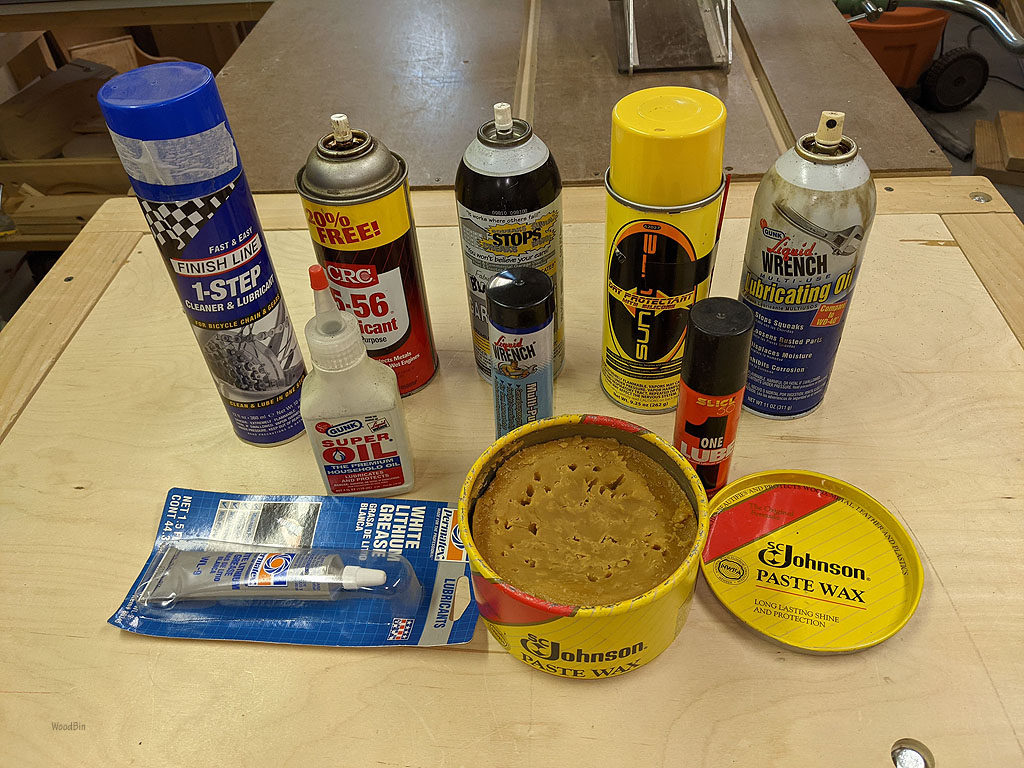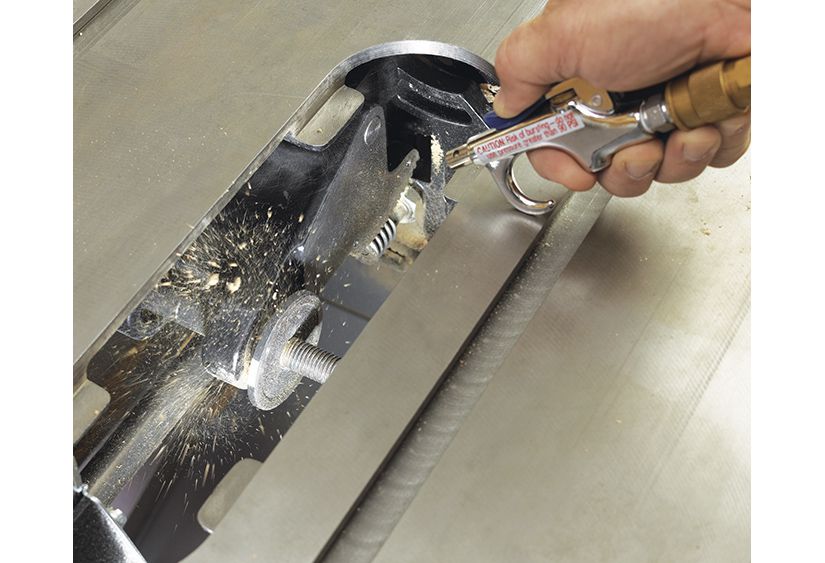Are you wondering what to use to lubricate your table saw? Well, look no further! Keeping your table saw well-maintained is crucial for its performance and longevity. In this guide, we’ll explore the best lubricants to use, how to apply them, and why regular lubrication is essential. So, let’s dive in and get your table saw running smoothly!
When it comes to lubricating a table saw, you want a product that can handle the demands of the machine. One popular option is a dry lubricant, such as a silicone spray or a Teflon-based lubricant. These lubricants provide a thin, protective coating that reduces friction without attracting dust and debris. Another excellent choice is a specialized table saw lubricant that is specifically designed for the saw’s moving parts.
Now, you might be wondering, why is lubrication so important for your table saw? Well, regular lubrication prevents excessive wear and tear on the components, reduces heat buildup, and ensures smooth and accurate cuts. It also helps prevent rust and corrosion, extending the lifespan of your beloved table saw. So, by taking a few minutes to lubricate your saw properly, you’ll be rewarded with improved performance and a longer-lasting tool. Let’s jump into the guide and learn how to do it right!

What to Use to Lubricate a Table Saw: A Comprehensive Guide
Table saws are an essential tool for woodworking enthusiasts, but to keep them running smoothly and prevent wear and tear, proper lubrication is crucial. In this comprehensive guide, we will explore the different lubricants that can be used to maintain your table saw, providing detailed information and tips along the way. Whether you are a beginner or an experienced woodworker, this article will help you understand what lubricants to use and how to keep your table saw in optimal condition.
The Importance of Lubrication for Table Saws
Lubrication plays a vital role in the performance and longevity of your table saw. It reduces friction between moving parts, allowing them to operate smoothly and efficiently. Proper lubrication also helps prevent rust and corrosion, extends the lifespan of your table saw, and ensures accurate and safe cuts. Without regular lubrication, your table saw may experience unnecessary wear and tear, leading to decreased performance and potential damage.
1. Types of Lubricants for Table Saws
When it comes to lubricating your table saw, several different types of lubricants can be used. It is important to choose the right lubricant based on the specific needs and requirements of your table saw. Here are some commonly used lubricants:
- White Lithium Grease: This lubricant is ideal for table saws as it provides excellent lubrication and protects against rust and corrosion. It is easy to apply and provides long-lasting lubrication.
- Silicone Spray: Silicone sprays are commonly used to lubricate various tools and machinery. They are non-greasy and provide a smooth and even coating to reduce friction.
- Machine Oil: Machine oil, such as SAE 30 oil or 3-in-1 oil, can also be used to lubricate table saws. It is important to choose a high-quality machine oil that is specifically designed for this purpose.
- Dry Lubricants: Dry lubricants, such as graphite powder or Teflon-based sprays, can be used to reduce friction and prevent debris from sticking to the moving parts.
- Paste Wax: Paste wax, commonly used for woodworking projects, can also be applied to the table and fence of your table saw to reduce friction and promote smooth operation.
It is crucial to read the manufacturer’s recommendations and guidelines before applying any lubricant to your table saw. Some manufacturers may recommend specific lubricants or provide instructions on the best application methods for their particular models.
Best Practices for Lubricating Your Table Saw
2. Lubrication Frequency
The frequency of lubrication will depend on how often you use your table saw and the manufacturer’s recommendations. In general, it is recommended to lubricate your table saw at least once every few months, or more frequently if you use it extensively. Regular maintenance and lubrication will help keep your table saw in optimal condition and prevent unnecessary wear and tear.
3. Lubrication Points
When lubricating your table saw, it is important to pay attention to specific lubrication points. These include:
- Arbor: The arbor is the shaft that holds the saw blade in place. Apply a small amount of lubricant to the arbor to ensure smooth rotation.
- Miter Gauge: Lubricate the miter gauge to ensure smooth and precise angle adjustments when making cuts.
- Table Surface: Apply a thin layer of lubricant, such as paste wax, to the table surface to reduce friction and allow the workpiece to glide smoothly.
- Fence: Lubricate the fence mechanism to ensure it moves easily and locks securely in place.
- Blade Height and Bevel Adjustment Mechanism: Apply lubricant to the height and bevel adjustment mechanisms to ensure smooth operation and accurate cuts.
Always refer to your table saw’s user manual for specific instructions on where to apply lubricant and the recommended lubrication points.
4. Cleaning before Lubrication
Prior to applying any lubricant, it is essential to clean your table saw thoroughly. Remove any sawdust, debris, or dirt from the table surface, blade, and all moving parts. This will help prevent the buildup of contaminants that can affect the performance and efficiency of your table saw.
Common Mistakes to Avoid when Lubricating a Table Saw
5. Over-lubrication
Applying too much lubricant can be just as detrimental as not lubricating at all. Excessive lubrication can attract more sawdust and debris, leading to clogging and affecting the performance of your table saw. Follow the manufacturer’s guidelines and apply the recommended amount of lubricant.
6. Using the Wrong Type of Lubricant
Using the wrong type of lubricant can cause damage to your table saw and compromise its performance. Always use the lubricant recommended by the manufacturer or consult the user manual for guidance. Using incompatible lubricants can lead to sticky residues, increased friction, and potential damage to the table saw’s components.
7. Neglecting Regular Maintenance
Lubrication is just one aspect of regular maintenance for your table saw. Neglecting other maintenance tasks, such as cleaning, alignment checks, and blade sharpening, can also impact the overall performance and longevity of your table saw. It is important to establish a comprehensive maintenance routine to ensure your table saw remains in optimal condition.
By following these best practices and avoiding common mistakes, you can effectively lubricate your table saw and keep it running smoothly for years to come. Regular maintenance and proper lubrication will not only extend the lifespan of your table saw, but also ensure precise and safe cuts for your woodworking projects.
Conclusion
In conclusion, the appropriate lubrication of your table saw is essential for ensuring its optimal performance and longevity. By choosing the right lubricant, following the manufacturer’s guidelines, and establishing a regular maintenance routine, you can ensure that your table saw operates smoothly and delivers accurate cuts. Remember to clean your table saw thoroughly before applying any lubricant and to lubricate the specific points recommended by the manufacturer. By adhering to these best practices, you can enjoy the benefits of a well-lubricated table saw and enhance your woodworking experience.
Key Takeaways – What to Use to Lubricate Table Saw
- Regular maintenance is essential to keep your table saw running smoothly.
- Use a specialized lubricant designed for table saws to prevent rust and ensure proper operation.
- Apply the lubricant to the moving parts of the saw, such as the arbor and the gears.
- Make sure to clean any excess debris or sawdust before lubricating.
- Follow the manufacturer’s recommendations for lubrication frequency and quantity.
Frequently Asked Questions
Welcome to our FAQ section where we answer common questions about lubricating your table saw. Proper lubrication is essential for keeping your table saw running smoothly and maintaining its performance. Read on to find answers to some of the most frequently asked questions on what to use to lubricate a table saw.
1. How often should I lubricate my table saw?
It’s recommended to lubricate your table saw every three to six months, depending on how frequently you use it. Regular lubrication helps reduce friction, prevents rust, and extends the lifespan of your table saw. If you notice any unusual noises or stiff movements, it’s a sign that your table saw needs lubrication.
When lubricating your table saw, make sure to clean any debris or sawdust from the surfaces. Use a high-quality lubricant that is designed specifically for table saws to ensure optimal performance and protection.
2. What type of lubricant should I use for my table saw?
When it comes to lubricating your table saw, it’s important to use the right type of lubricant. Avoid using general-purpose lubricants as they may not be suitable for the specific needs of a table saw. Instead, opt for a lubricant that is specifically formulated for table saws or power tools.
Look for a lubricant that is designed to reduce friction, repel moisture, and provide long-lasting protection. Silicone-based lubricants or dry lubricants are often recommended for table saws as they offer excellent lubrication without attracting dust or creating a sticky residue.
3. How should I apply lubricant to my table saw?
Before applying lubricant to your table saw, make sure to clean the surfaces from any debris or sawdust. Wipe the surfaces with a clean cloth or brush to remove any loose particles.
Once the surfaces are clean, apply a small amount of lubricant to a clean cloth or rag. Gently rub the lubricant onto the surfaces, focusing on the moving parts, such as the arbor and blade elevation mechanisms. Avoid applying excessive lubricant, as it can attract more debris and create a mess.
4. Are there any parts of a table saw that should not be lubricated?
While lubricating your table saw is important, there are certain parts that should not be lubricated. Avoid lubricating the table saw’s cutting surface or the area where the wood comes into contact with the saw blade. Lubricants can interfere with the wood’s grip and compromise safety.
Additionally, you should also avoid lubricating the miter gauge slot, as lubricants can attract dust and affect the accuracy of your cuts. Focus on lubricating the moving parts, such as the blade elevation mechanisms, arbor, and gears.
5. How can I tell if my table saw needs lubrication?
There are a few signs that indicate it’s time to lubricate your table saw. If you notice unusual noises when operating the saw, such as squeaking or grinding sounds, it’s likely that your table saw needs lubrication. Stiff movements or resistance when adjusting the blade height or bevel angle are also signs of inadequate lubrication.
Regular inspection is crucial to identify any signs of wear or lack of lubrication. If you see any rust or corrosion on the metal surfaces, it’s a clear indication that you should lubricate your table saw. Remember, proper lubrication is key to ensuring smooth and precise cuts, as well as prolonging the life of your table saw.

WARNING: This table saw lubrication tip will tick people off!
Summary
So, when it comes to lubricating your table saw, there are a few key things to remember. First, make sure to use the right type of lubricant – either oil or wax-based. Second, apply the lubricant regularly to keep your saw running smoothly and prevent rust. Lastly, be careful not to apply too much lubricant, as it can cause build-up and affect your saw’s performance. By following these tips, you’ll be able to keep your table saw in top shape and ensure it lasts for years to come. Happy woodworking!
